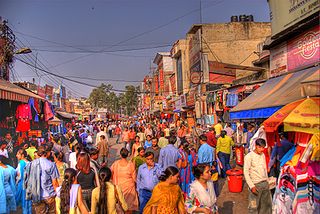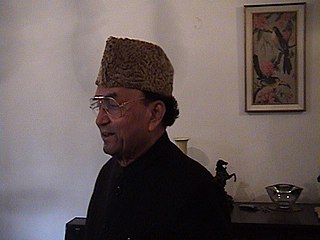
Akhil Bharat Hindu Mahasabha is a Hindu nationalist political party in India.

Devi Lal, also known as Chaudhary Devi Lal, was an Indian statesman and politician who served as 6th Deputy Prime Minister of India from 1989 to 1990 and from 1990 to 1991. Lal emerged as farmer leader from the state of Haryana, and served as the Chief Minister of Haryana from 1977 to 1979 and then from 1987 to 1989. He was the founder of Indian National Lok Dal. He was popularly known as Tau, meaning uncle.

Krishan Kant was an Indian politician who served as the tenth vice president of India from 1997 until his death in 2002. Prior to his vice presidency, Kant was the governor of Andhra Pradesh from 1990 to 1997. He was a member of both houses of the Indian Parliament, representing Chandigarh in the Lok Sabha from 1977 to 1980, and Haryana in the Rajya Sabha from 1966 to 1977.

Balwantrai Mehta was an Indian politician who served as the second Chief Minister of Gujarat state, India. He participated in Indian independence movement and later held various public offices. He is considered as the 'Architect of Panchayati Raj ' due to his contributions towards democratic decentralisation.

Lajpat Nagar is a residential and commercial neighborhood in the South East Delhi district of Delhi. It was named in honor of Lala Lajpat Rai and is today most known for the Lajpat Nagar Central Market. This area is not to be confused with the Lajpat Nagar in Ghaziabad in the NCR region.

Ranbir Singh Hooda was an Indian freedom fighter, parliamentarian and administrator from state of Haryana known for taking up the cause of poor and backward people and peasants. He actively participated in the freedom struggle, and was jailed five times.

Hisar district is one of the 22 districts of Haryana, India. Hisar city serves as the district headquarters. Hisar district has four sub-divisions that is, Hisar, Barwala, Hansi and Narnaud, each headed by an SDM. The district is also part of Hisar division. Hisar was founded by Firuz Shah Tughlaq.

Lala Lajpat Rai was an Indian revolutionary, politician, and author, popularly known as Punjab Kesari. He was one of the three members of the Lal Bal Pal trio. He died of severe head trauma injuries sustained 18 days earlier during a baton charge by police in Lahore, when he led a peaceful protest march against the British Simon Commission Indian constitutional reforms.

Sukhdev Thapar was an Indian freedom fighter who fought against the British government for the freedom of India. He was a member of the Hindustan Socialist Republican Association (HSRA). He was executed along with Shivaram Rajguru and Bhagat Singh on 23 March 1931.

Majha is a region located in the central parts of the historical Punjab region split between India and Pakistan. It extends north from the right banks of the river Beas, and reaches as far north as the river Jhelum. People of the Majha region are given the demonym "Mājhī" or "Majhail". Most inhabitants of the region speak the Majhi dialect, which is the basis of the standard register of the Punjabi language. The most populous city in the area is Lahore on the Pakistani side, and Amritsar on the Indian side of the border.

Bhai Parmanand was an Indian nationalist and a prominent leader of the Ghadar Party and Hindu Mahasabha.
Servants of the People Society (SOPS) is a non-profit social service organization founded by Lala Lajpat Rai, a prominent leader in the Indian Independence movement, in 1921 in Lahore. The society is devoted to "enlist and train national missionaries for the service of the motherland". It was shifted to India, following the partition of India in 1947, and functioned from the residence of Lala Achint Ram, a founder member and Lok Sabha, M.P. at 2-Telegraph Lane, New Delhi. In 1960, after the construction of the new building its shifted to Lajpat Bhawan, Lajpat Nagar, in Delhi. Today, it has branches in many parts of India.

Lala Hansraj also known as Mahatama Hansraj, was an Indian educationist and a follower of Arya Samaj movement founder, Swami Dayanand. He founded, with Gurudatta Vidhyarthi, the Dayanand Anglo-Vedic Schools System (D.A.V.) in Lahore on 1 June 1886, where the first D.A.V. school was set up in memory of Dayanand who had died three years earlier.

Vijay Kumar Chopra is the chief executive officer and editor in chief of the Punjab Kesari print news organisation. He is involved in social welfare work and has received a Padma Shri award. In August 2009, he was elected by the Chairman of the Press Trust of India.

Subhadra Joshi was an Indian freedom activist, politician and parliamentarian from Indian National Congress. She took part in the 1942 Quit India movement, and later remained the president of the Delhi Pradesh Congress Committee (DPCC). She was from Sialkot.

Amarnath Vidyalankar was an Indian politician, social worker and journalist. He was involved in the independence movement and became a member of the Indian National Congress before India's independence in 1947. After independence, Vidyalankar served as Minister of Education, Labor and Languages in the Government of Punjab from 1957 to 1962 and was a member of the First (1952–1956), Third (1962–1967) and Fifth (1971–1977) Lok Sabhas.

Satyavati Devi was an Indian freedom fighter and Gandhian. At the time of her death on 26 October 2010, she was India's oldest living freedom fighter.

Rajni Ranjan Sahu is a former member of parliament (MP) in India. He represented the state of Bihar in Rajya Sabha for two six-year terms (1984–1996) as a member of the Congress party (I).

Babu Mool Chand Jain, often referred to as "Gandhi of Haryana", - a Gandhian who was a member of the Congress Party, Vishal Haryana Party, Janata Party, Lok Dal and then Haryana Vikas Party at different times. He was a freedom fighter in the Indian independence movement, parliamentarian, lawyer, Satyagrahi social activist, and Indian statesman who also served as Excise & Taxation and Public Works Department Minister in Joint Punjab as well as Finance Minister, Deputy Chairman.

Deshbandhu Gupta, also known as Lala Deshbandhu Gupta, was an Indian freedom fighter, politician, and journalist. He served as a member of the Punjab Provincial Assembly, having won the 1937 election representing the Indian National Congress. He was also a member of the Constituent Assembly of India.



















